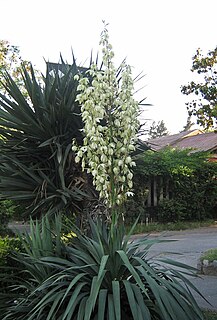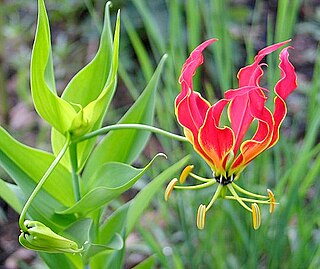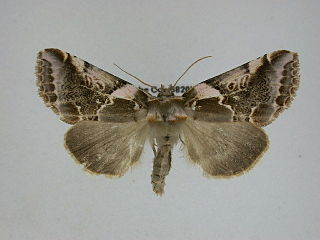
Gloriosa is a genus of 12 species in the plant family Colchicaceae, and includes the formerly recognised genus Littonia. They are native in tropical and southern Africa to Asia, and naturalised in Australia and the Pacific as well as being widely cultivated. The most common English names are flame lily, fire lily, gloriosa lily, glory lily, superb lily, climbing lily, and creeping lily.

Yucca gloriosa is a species of flowering plant in the family Asparagaceae, native to the southeastern United States. Growing to 2.5 m (8 ft), it is an evergreen shrub. It is widely cultivated as an ornamental for its architectural qualities, and has reportedly become established in warmer climates in the wild in various parts of the world.

Cosmopterix is a large genus of moth in the family Cosmopterigidae.

Chrysina gloriosa is a species of scarab whose common names are glorious beetle and glorious scarab. The adults are 25 to 28 millimetres long and are bright green with silver stripes on the elytra. These iridescent stripes on the cuticle of the elytra are a result of cholesteric liquid crystal organization of chitin molecules. The differences in color are a result of the microscopic structure of each section, with green reflected from cusp-like structures and silver reflected from flat layers parallel to the surface of the elytra. As established through Mueller matrix spectroscopic ellipsometry, the optical properties change with the incidence angle of the propagating light. The polygonal cells in the green stripes generate self-healing Bessel beams. The adults eat juniper leaves at a high elevation and are able to camouflage by blending in with plants. The species is sometimes incorrectly thought to be endangered, but has never been listed either in the IUCN Red List of Threatened Species or under the United States Endangered Species Act. An invalid synonym used to be Plusiotis gloriosa.
Metalopha gloriosa is a moth of the family Noctuidae first described by Otto Staudinger in 1887. It is found from western Turkey to eastern Taurus Mountains, Iraq, Anatolia, Israel, Jordan, Lebanon and Syria.

Gloriosa superba is a species of flowering plant in the family Colchicaceae. Common names include flame lily, climbing lily, creeping lily, glory lily, gloriosa lily, tiger claw, agnishikha and fire lily.
Cosmopterix ancalodes is a moth in the family Cosmopterigidae. It was described by Edward Meyrick in 1919. It is found in India.
Cosmopterix antemidora is a moth in the family Cosmopterigidae. It was described by Edward Meyrick in 1909. It is found in Kodagu district of India.
Cosmopterix aphranassa is a moth in the family Cosmopterigidae. It was described by Edward Meyrick in 1926. It is found on Rapa Iti.
Cosmopterix artifica is a moth in the family Cosmopterigidae. It was described by Edward Meyrick in 1909. It is found in Sri Lanka.
Cosmopterix calypso is a moth in the family Cosmopterigidae. It was described by Edward Meyrick in 1919. It is found in India.
Cosmopterix erethista is a moth in the family Cosmopterigidae. It was described by Edward Meyrick in 1909. It is found in India.
Cosmopterix licnura is a moth in the family Cosmopterigidae. It was described by Edward Meyrick in 1909. It is found in India.
Cosmopterix ligyrodes is a moth in the family Cosmopterigidae. It was described by Edward Meyrick in 1915. It is found in India.
Cosmopterix luteoapicalis is a moth in the family Cosmopterigidae. It was described by Sinev in 2002. It is found in the Democratic Republic of the Congo and Senegal.
Cosmopterix manipularis is a moth in the family Cosmopterigidae. It was described by Edward Meyrick in 1909. It is found in Kodagu district, India.
Cosmopterix pustulatella is a moth in the family Cosmopterigidae. It is found on Java.
Cosmopterix toraula is a moth in the family Cosmopterigidae. It is found on Borneo.

Habrosyne gloriosa, the glorious habrosyne moth, is a moth in the family Drepanidae. It is found in North America, where it has been recorded from the northern United States, south in the Rocky Mountains to Arizona. In Canada, it is found in Ontario and Quebec.

My Little Pony: Equestria Girls – Legend of Everfree, or simply known as Legend of Everfree, is a 2016 Canadian–American flash animated musical fantasy film sequel to 2015's My Little Pony: Equestria Girls – Friendship Games, written by Kristine Songco and Joanna Lewis, and directed by Ishi Rudell. The film was produced by DHX Media's 2D animation studio in Vancouver, Canada for Hasbro Studios in the United States as a part of Hasbro's Equestria Girls toy line and media franchise, which is a spin-off of the 2010 relaunch of My Little Pony. Prior to its release in the United States on Netflix on October 1, 2016, the film was first broadcast on Discovery Kids in Latin America on September 24, 2016. It received a home media release in the United States and Canada on November 1, 2016. The film received mixed reviews from critics, who praised the animation, voice acting and music, but criticized its script, plot and excessive use of too many plotlines all at once.






